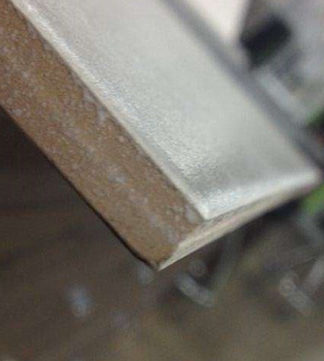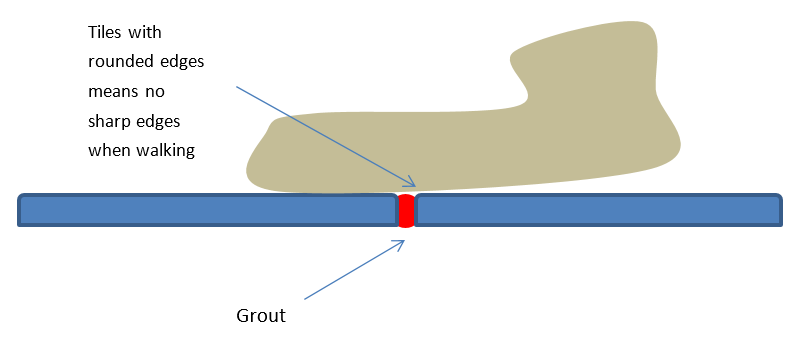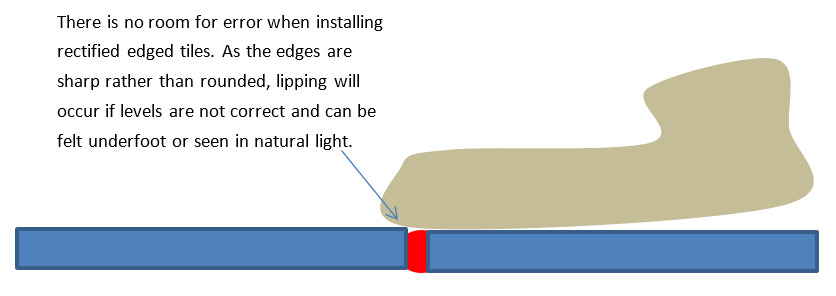General Info about Ceramic and Porcelain Tiles
Tile Definitions Explained
First thing’s first – it’s important to note that all tiles, whether they are ceramic, glazed porcelain, vitrified porcelain, etc., are all in fact ‘ceramic tiles’. The difference is in the production process in terms of how refined and pressed the base is, or what temperature the tile is fired at. These variations in the production process then determine the tile’s ability to be glazed (applying colour to the surface), or mechanically treated to create a textured, honed or polished finish.
Glazed Ceramic Tiles
Glazed Ceramic tiles are known by many names, some common are Monocottura, Monoporosa or Bicottura. They are single (mono) or double (bio) fired tiles, generally at around 1000 degrees Celsius. Because of their softer ‘structural body’, also referred to as biscuit, a protective layer of engobe and glaze is applied to the tile surface.

Porcelain Tiles
Like Glazed Ceramic, Porcelain tiles have also been in existence for many years. In the past, they were predominately used in commercial applications, because the resources and technology needed to produce this product came at quite an expense.
However, in the last 10 – 20 years there has been an increased availability of this product in both glazed (like Glazed Ceramic) and technical finishes (like Polished Porcelain, see Figure 5) as improvements in technology and process methods have resulted in lower production costs. The increased demand has resulted in a more economical product, while still being excellent quality, and exhibiting great product consistency.
Rounded Edges (Cushion Edge)


Rectified Edges


Batch/Shade Variations
An inherent property of tiles is batch or shade variation. Again, going back to our cakes, you are never going to get identical looking cakes out of one cooking period. The mix of clays and firing process in tile production means that within one run, we could end up with multiple batches or shades. Luckily, we have moved on from visual inspection of tiles to determine shade consistency. Advanced technology is able to sort out one from another pretty easily and our stock control systems mean that we will only send out one batch/shade per house lot, so there is no need to stress.
Batching and shade variations are inevitable in all tile products, and the tile you have chosen is indicative only to what you may receive. There may be no issue, or it may vary slightly, however it will still go well with your selection.
To achieve a natural, realistic look, most ranges carry a little variation from tile to tile. In some cases, ranges can have a V rating of V3-V4. Tiles with these ratings generally have a heavy variation from tile to tile and can change in colour and/or pattern to achieve the desired look.
There is a rating chart that governs this design variation (see Figure 12).

Figure 12: Tile variation ratings
Anti-Slip Systems
Slip Resistance can be very technical, but in simple terms, you must choose a tile that is suitable for the specified area, and in most cases, it is very logical. Slip Resistance comes into play when we are talking about tiles for balconies, patios, alfresco and even in shower bases.
With regards to tiles in shower bases, although there is no governance on this with residential applications, we strongly advise not to use high gloss Glazed Ceramic or Glazed Porcelain, or Technical tiles with a honed, semi or full polished surface.
Tip: Slip Resistant tiles are harder to clean than non-slip internal tiles. Ideally use a hard bristle brush to scrub off dirt, then mop away with clean water or hose off if outside.
Laying Brick Bond
Oblong shape tiles, like 300mmx600mm, 400mmx800mm or even 600mmx1200mm, are generally made by cutting down larger tiles. This is more so with Technical Porcelain. When tiles are made, it is a natural characteristic for the tile to have some curvature or bow, that is where the centre of the tile is raised. (See Figure 9)

Figure 9
Because of this, when a tile is laid in a brick bond fashion, the middle of the tile does not line up with the ends of the other tiles. This unevenness is referred to as ‘lipping’ and can be felt underfoot or seen in natural light. (See Figure 10)

Figure 10: Tile lipping
To avoid this lipping, we advise people not to tile in a brick bond fashion without checking that the curvature of the tile is minimal and therefore avoiding the variation. If, however, there is some curvature and the client wishes to have a brick bond effect, we recommended that tile is staggered only 200mm of the tile edge, rather than half (as per normal brick bond finish). By doing this, you can hide the curvature to a degree and still have that staggered look. (See Figure 11)

Figure 11: Brick Bond Tile Layouts
Cleaning Instructions
Please view our Tile Care section, or our Caring For Your Floors – Tiles Brochure.

